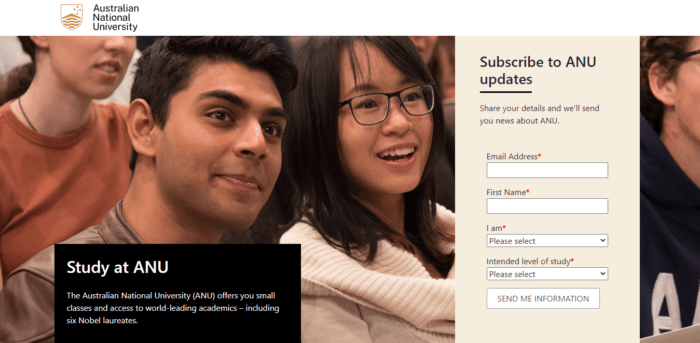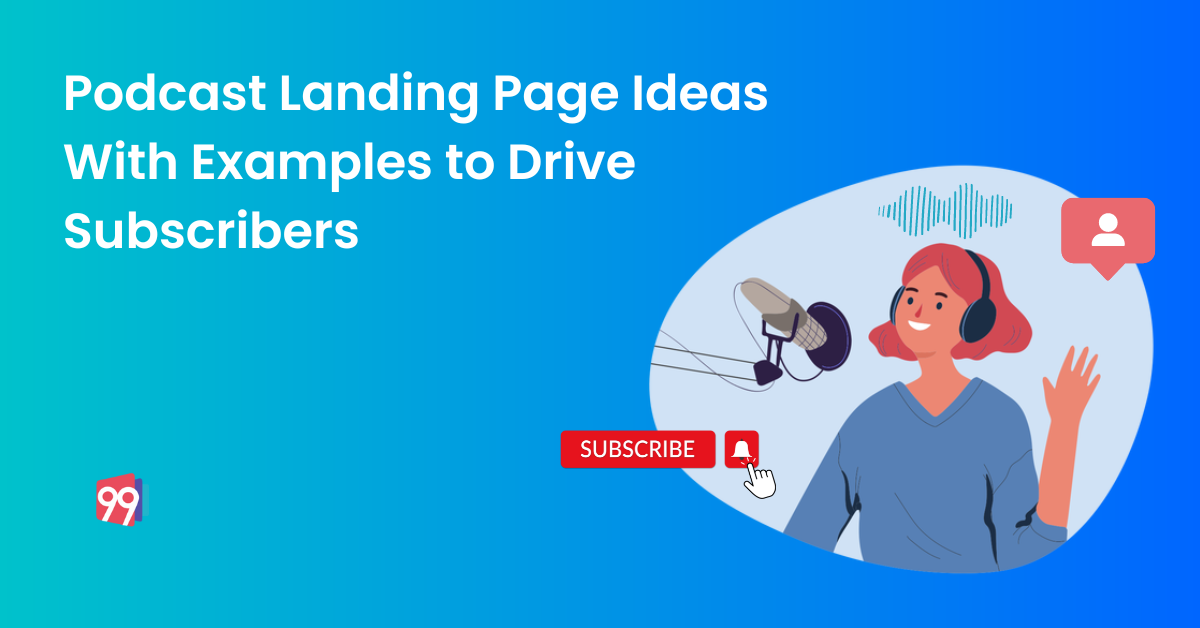Lead generation in higher education is getting more competitive day by day. It is no secret that colleges are under tremendous pressure to improve their outreach programs and gain better admission rates.
Traditional communication methods like college magazines or word of mouth have lost their shine. Due to the internet, most prospective students research their dream colleges via smartphone or laptop. So it becomes crucial that you are ready with the right content and admission funnel to recruit students swiftly.
Lead generation through landing pages allows colleges to connect with students worldwide with just a few clicks. It enables dynamic marketing strategies that facilitate better interaction with prospective students and enhance market rapport. When executed effectively, lead generation can significantly improve colleges’ performance during the admission season.
This article explores strategies for lead generation in higher education, focusing on leveraging landing pages to boost admission rates. These strategies are tailored for educational institutions and aim to maximize marketing efforts for optimal results in lead generation.
Table of Content
- What is Lead Generation in Higher Education?
- How do Landing Pages Contribute To Lead Generation in Higher Education
- Effective Strategies for Maximising Lead Generation in Higher Education through Landing Pages
- Exploration of new technologies or tactics shaping lead generation in higher education
What is Lead Generation in Higher Education?
Lead generation in higher education is the strategic process of enticing and capturing the attention and contact details of potential students, aiming to convert them into enrolled students.
It revolves around pinpointing and engaging with prospective students who exhibit an interest in pursuing academic programs, courses, or other educational offerings provided by colleges, universities, or similar institutions of higher learning.
This involves employing various marketing tactics and outreach methods tailored to the unique preferences and behaviours of individuals seeking educational opportunities.
How do Landing pages Contribute to Lead Generation in Higher Education?
Lead generation for colleges and universities heavily relies on effective landing pages to attract prospective students. Unlike traditional industries, higher education institutions have innovatively utilized landing pages to provide essential information to potential students, aiding them in making informed decisions about their educational journey.
These landing pages serve as digital hubs where universities showcase their unique offerings, including specific programs, affordability options, and advantageous locations.
By aligning their landing pages with the desires of potential students, universities can effectively capture leads and guide them through the enrollment process.
Here’s how landing pages contribute to lead generation in higher education:
1. Focused Information:
Tailored content highlights specific programs, courses, or events, grabbing the attention of interested individuals.
2. Clear CTAs:
Landing pages usually feature a clear and persuasive call-to-action, prompting visitors to proceed with the enrollment journey. This could involve actions like scheduling a campus tour, requesting more information, or starting an application. The CTA acts as a catalyst for converting visitors into leads, encouraging them to further engage with the institution.
3. Lead Capture Forms:
Integrated lead capture forms on landing pages enable institutions to gather valuable contact information from prospective students. These forms may collect details such as name, email address, phone number, academic interests, and intended start date. By capturing these leads, universities can initiate personalised communication and nurture relationships with potential applicants.
4. Analytics Tracking:
Allows institutions to track key metrics such as conversion rates, click-through rates, and form submissions. By analysing these metrics, higher education marketers can identify which pages and campaigns are most effective at generating leads and optimise their strategies accordingly.
5. Automation Integration:
Landing pages can be integrated with marketing automation platforms to streamline lead nurturing processes. Once a visitor fills out a form on a landing page, their information can be automatically added to a CRM system and trigger automated email sequences or other follow-up actions.
6. A/B Testing:
Higher education marketers can conduct A/B tests on landing pages to optimise conversion rates. By experimenting with different headlines, copywriting, imagery, and CTAs, institutions can identify which variations resonate best with their target audience and refine their messaging accordingly.
Effective Strategies for Maximising Lead Generation in Higher Education
Lead generation in higher education demands, precision only works when you utilise the right tactics for the right business. When it comes to the higher education sector, there are some strategies that work great, and there are some that do not work at all. But you don’t have to go through the pain of searching for the best lead generation methods as we have compiled a list for you.
Let’s explore these strategies, with a particular emphasis on optimizing their effectiveness through landing pages.
1. Personalised Messaging:
When it comes to lead generation in higher education through landing pages, personalized messaging is a powerful strategy. This involves tailoring content to each visitor, greeting them by name, and presenting information that matches their interests. Schools often add perks such as scholarships or dorm discounts right on these pages to attract potential students.
Personalised content helps build trust with potential students, making them more likely to share the page with friends. This word-of-mouth sharing boosts the page’s reach and effectiveness, ultimately aiding in lead generation efforts. Plus, by personalising, schools can see which marketing tactics work best and adjust their strategies in real-time to optimize lead generation.
In essence, personalized marketing on educational landing pages plays a crucial role in lead generation efforts in higher education. It gets people engaged, encourages sharing, and helps schools fine-tune their future campaigns to attract more prospective students.
2. Social Media Marketing
Harnessing the power of social media, colleges can effectively strengthen lead generation efforts in higher education, especially when integrated with optimised landing pages. Engaging content such as student photos or campus news feeds can attract prospective students to your institution.
Colleges have discovered that social media not only serves as a marketing platform but also offers a unique opportunity for prospective students to interact and ask questions about the college thereby enriching lead generation in higher education. During these interactions, students may voluntarily provide personal information that can be leveraged later in the lead generation process.
Integrating social media with landing pages allows for seamless lead capture. By directing social media traffic to landing pages tailored to specific campaigns or offerings, colleges can efficiently collect and utilize prospect data to nurture leads and guide them through the enrollment process. This synergy between social media and landing pages enhances lead generation efforts in higher education, facilitating meaningful engagement and conversion of prospective students.
3. Content Marketing:
Content marketing serves as a pivotal strategy for lead generation in higher education, particularly when integrated into landing pages. By crafting various content types such as blog posts, videos, and podcasts, colleges and universities aim to attract prospective students and guide them towards enrollment.
One effective approach involves targeting local high school students, a key demographic for lead generation. For example, institutions can create content like articles or videos highlighting the experience of attending the school, enticing nearby students to explore further and potentially become leads.
Similarly, targeting individuals considering transferring schools offers another avenue for lead generation. By showcasing excellent programs and easy transfer processes through tailored content, institutions can attract transfer students seeking better academic opportunities.
By strategically integrating content marketing efforts into their landing pages, colleges and universities can effectively engage prospective students, providing valuable information and nurturing them as leads in the higher education enrollment process.
4. Paid Campaigns:
Paid campaigns are a powerful tool for generating leads in higher education when paired with landing pages. With their precision targeting, these campaigns connect colleges and universities with the right audience. By strategically advertising to students searching for similar courses, paid campaigns ensure the message reaches those most interested.
One great advantage of paid campaigns is their ability to direct visitors to dedicated landing pages. By targeting the right keywords and crafting compelling ads, institutions can encourage potential students to click through to these pages for more information.
Landing pages play a key role in the lead generation in higher education process, acting as the first point of contact after clicking an ad. They should offer engaging content that prompts visitors to take action, like filling out a contact form.
By combining paid campaigns with optimized landing pages, colleges can effectively engage with prospective students and guide them towards enrollment. This seamless approach ensures a smoother lead generation process and boosts conversion rates.
For example, let’s look at how the Australian National University (ANU) uses paid campaigns to connect with students. When you search for “Australian University” on Google, you’ll find ANU’s ad at the top of the search results. Clicking on the ad leads you to a landing page that provides comprehensive information about the university, its courses, and much more.
You can use paid marketing on various channels like Google, Facebook, LinkedIn, Instagram, and others where young people typically spend a lot of time. Choose the right channels for your institution and start advertising to effectively reach and engage with prospective students.
Suggested Read: 5 Essentials of an Effective Lead Generation Landing Page
5. Screening Potential Applicants
Many universities and colleges streamline their applicant screening process through online forms, directing potential applicants to landing pages tailored to their qualifications. If applicants do not meet the school’s minimum requirements, they are redirected to a landing page that explains why they were not accepted and encourages them to apply again in the future, thus fostering continuous lead generation in higher education.
This method of lead generation is highly effective as it allows admissions officers to save time and energy by focusing their efforts on candidates who meet the school’s criteria. Simultaneously, it serves to discourage applicants who do not qualify, thus optimising resources. Moreover, this approach enhances the institution’s credibility and trustworthiness by demonstrating a transparent and fair admissions process, which contributes to sustained lead generation efforts in higher education.
Exploration of New Technologies Shaping Lead Generation in Higher Education
1. AI-Powered Chatbots:
Utilizing AI-powered chatbots on university websites to engage with prospective students in real-time, providing information, answering questions, and assisting with the application process.
2. Virtual Assistants and Voice Search Optimization:
With the increasing popularity of voice-activated devices and virtual assistants like Siri and Alexa, optimizing content for voice search can improve visibility and attract prospective students seeking information about educational opportunities.
3. Virtual Campus Tours and Events:
Offering virtual campus tours and events using VR and AR technologies, enabling prospective students to explore campuses, attend lectures, and interact with faculty and current students remotely.
4. Micro-Credentials and Online Learning Platforms:
The demand for flexible learning options has led to the proliferation of online learning platforms and micro-credential programs. Institutions are leveraging these platforms to attract non-traditional students and working professionals interested in upskilling or reskilling, thereby expanding their pool of potential leads.
5. Marketing and Accessibility Initiatives:
Implementing inclusive marketing strategies and accessibility initiatives to ensure that all prospective students, including those with disabilities or diverse backgrounds, feel welcome and supported throughout the enrollment journey.
6. Community Engagement Platforms for Alumni and Current Students:
Creating community engagement platforms that connect alumni and current students with prospective students, allowing them to share insights, experiences, and advice, strengthening the sense of belonging and affinity with the institution.
Conclusion:
In conclusion, the landscape of lead generation in higher education is undergoing rapid evolution, necessitating innovative strategies for colleges and universities to maintain competitiveness. Unlocking the full potential of lead generation requires adeptly leveraging resources and tailoring them to individual needs. Utilizing landing pages as digital gateways, institutions can engage effectively with prospective students, providing bespoke information and personalized experiences that resonate with their interests and ambitions.
By embracing these strategies and remaining adaptable amidst shifting trends and technological advancements, higher education institutions can position themselves for enduring success in lead generation in higher education. Through targeted marketing efforts, seamless digital experiences, and a dedication to meeting the evolving needs of students, enrollment rates can be bolstered while fostering deeper connections with the upcoming generation of learners. This proactive approach not only ensures institutional viability but also contributes to shaping a brighter future for both academia and students.
Furthermore, institutions have an array of tools at their disposal to streamline enrollment processes and attract diverse student cohorts. From crafting personalised messaging to seamlessly integrating social media platforms and exploring cutting-edge technologies such as AI chatbots and virtual tours,universities can enhance their outreach efforts significantly.
For those seeking to optimise their marketing endeavor’s, considering conversion-focused landing page templates offered by platforms like 99landing pages can provide a valuable shortcut to achieving admission goals. 99landing pages is a website that provides you with all types of landing page templates you need to reach your admission goals.
Check out our collection now: 99landingpages
Other interesting reads:
Lead Generation For Nonprofit Organisations: A Step By Step Guide
Our Featured Templates:





